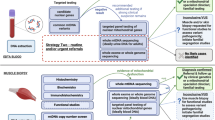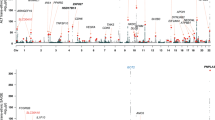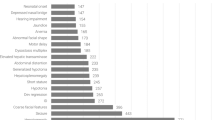Abstract
Wilson's disease (WD) is an inborn error of copper metabolism caused by a mutation to the copper-transporting gene ATP7B. The disease has an autosomal recessive mode of inheritance, and is characterized by excessive copper deposition, predominantly in the liver and brain. Diagnosis of the condition depends primarily on clinical features, biochemical parameters and the presence of the Kayser–Fleischer ring, and a new diagnostic scoring system has recently been proposed. Mutations in ATP7B can occur anywhere along the entire 21 exons, which makes the identification of gene defects particularly challenging. Identification of carriers and presymptomatic family members of affected individuals is achieved by polymerase-chain-reaction-based marker analysis. The traditional treatment for WD is based on copper chelation with agents such as D-penicillamine, but use of this drug has been questioned because of reported side effects. The use of agents such as trientine and ammonium tetrathiomolybdate has been advocated, although results of long-term trials are awaited. In selected cases, orthotropic hepatic transplantation can reverse the basic metabolic abnormality in WD and improve both hepatic and neurological symptoms. Studies of the underlying defects in ATP7B and its suspected modifiers ATOX1 and COMMD1 are expected to unravel the disease's genotype–phenotype correlation, and should lead to the design of improved drugs for ameliorating the suffering of patients.
Key Points
-
Wilson's disease is an inborn error of copper metabolism caused by a mutation to the copper-transporting gene ATP7B
-
Epidemiologic clustering of mutations to the ATP7B gene based on ethnicity have been observed
-
Diagnosis of the condition is made primarily on the basis of clinical findings, presence of the Kayser–Fleischer ring, and biochemical parameters
-
A new scoring system for diagnosis of the condition was proposed at the 8th International Conference on Wilson Disease and Menkes Disease, 2001
-
Treatment involves the use of a chelating agent, the most commonly used being D-penicillamine, and both symptomatic and presymptomatic affected individuals can be treated
-
Liver transplantation can be used for complete reversal of the metabolic abnormality
-
Early detection of presymptomatic individuals in affected families can be achieved by polymerase-chain-reaction-based linkage analysis using microsatellite markers
This is a preview of subscription content, access via your institution
Access options
Subscribe to this journal
Receive 12 print issues and online access
$209.00 per year
only $17.42 per issue
Buy this article
- Purchase on Springer Link
- Instant access to full article PDF
Prices may be subject to local taxes which are calculated during checkout





Similar content being viewed by others
References
Wilson SAK (1912) Progressive lenticular degeneration: a familial nervous disease associated with cirrhosis of the liver. Brain 34: 295–509
Cunning JN (1948) The copper and iron content of brain and liver in the normal and in hepatolenticular degeneration. Brain 71: 410–415
Frommer DJ (1974) Defective biliary excretion of copper in Wilson's disease. Gut 15: 125–129
Scheinberg DJ and Gitlin D (1952) Deficiency of ceruloplasmin in patients with hepatolenticular degeneration (Wilson's disease) Science 116: 484–485
Bull PC et al. (1993) The Wilson disease gene is a putative copper transporting P-type ATPase similar to the Menkes gene. Nat Genet 5: 327–337
Loudianos G et al. (1999) Molecular characterization of Wilson disease in the Sardinian population—evidence of a founder effect. Hum Mutat 14: 294–303
Yamaguchi Y et al. (1993) Isolation and characterization of a human liver cDNA as a candidate gene for Wilson disease. Biochem Biophys Res Common 197: 271–277
Frydman M et al. (1985) Assignment of the gene for Wilson disease to chromosome 13: linkage to the esterase D locus. Proc Natl Acad Sc USA 82: 1891–1821
Figus A et al. (1995) Molecular pathology and haplotype analysis of Wilson disease in Mediterranean populations. Am J Hum Genet 57: 1318–1324
The Human Gene Mutation Database, Institute of Medical Genetics, Cardiff [http://uwcmml1s.uwcm.ac.uk/uwcm/mg/search/120494.html] (accessed June 3 2006)
Wilson Disease Mutation Database, Department of Medical Genetics, University of Alberta [http://www.uofa-medical-genetics.org/wilson/index.php] (accessed June 3 2006)
Thomas GR et al. (1995) The Wilson disease gene: spectrum of mutations and their consequences. Nat Genet 9: 210–217
Kim EK et al. (1998) Identification of three novel mutations and a high frequency of the Arg778Leu mutation in Korean patients with Wilson disease. Hum Mutat 11: 275–278
Gupta A et al. (2005) Molecular pathogenesis of Wilson Disease: haplotype analysis, detection of prevalent mutations and genotype-phenotype correlation in Indian patients. Hum Genet 118: 49–57
Petrukhin K et al. (1993) Mapping, cloning and genetic characterization of the region containing the Wilson disease gene. Nat Genet 5: 338–343
Schiefermeier M et al. (2000) The impact of apolipoprotein E genotypes on age at onset of symptoms and phenotypic expression in Wilson's disease. Brain 123: 585–590
Vulpe C et al. (1993) Isolation of a candidate gene for Menkes disease and evidence that it encodes a copper-transporting ATPase. Nat Genet 3: 7–13
Valentine JS and Gralla B (1997) Delivering copper inside yeast and human cells. Science 278: 817–818
Yang XL et al. (1997) Two forms of Wilson disease protein produced by alternative splicing are localized in distinct cellular compartments. Biochem J 326: 897–902
Harris ED (2000) Cellular copper transport and metabolism. Annu Rev Nutr 20: 291–310
Schilsky M and Tavill AS (2003) Wilson disease. In Disease of the Liver, edn 9, 1169–1186 (Eds Schiff ER et al.) Philadelphia: Lippincott Williams & Wilkins
Sherlock S and Dooley J (Eds; 2002) Wilson disease. In Diseases of the Liver and Biliary System, edn 11, 413–422 Oxford: Blackwell Science
Mufti AR et al. (2006) XIAP is a copper binding protein deregulated in Wilson's disease and other copper toxicosis disorders. Mol Cell 21: 775–785
Scheinberg IH and Sternlieb I (1984) Wilson disease. Philadelphia: WB Saunders
Ala A et al. (2005) Wilson disease in septuagenarian siblings: raising the bar for diagnosis. Hepatology 41: 668–670
Le Witt P and Pfeiffe R (2002) Neurologic aspects of Wilson's disease: clinical manifestations and treatment considerations. In Parkinson's Disease and Movement Disorders, edn 4, 240–255 (Eds Jankovic JJ and Tolosa E) Philadelphia: Lippincott Williams & Wilkins
Kalra V et al. (2000) Wilson's disease: early onset and lessons from a pediatric cohort in India. Indian Pediatr 37: 595–601
Starosta-Rubinstein S et al. (1987) Clinical assessment of 31 patients with Wilson's disease: correlations with structural changes on magnetic resonance imaging. Arch Neurol 44: 365–370
Jha SK et al. (1998) Wilson's disease: clinical and radiological features. J Assoc Physicians India. 46: 602–605
Brewer GJ (2006) Wilson's disease. In Neurogenetics—scientific and clinical advances, 383–402 (Ed Lynch DR) New York: Taylor & Francis
Kwamura N et al. (2004) Serial diffusion weighted MRI in a case of Wilson's disease with acute onset of hemichorea. J Neurol 251: 1413–1414
Menkes JH (2003) Wilson disease. In Genetics of movement disorders, 341–352 (Ed Pulsat FM) Amsterdam: Academic Press
Meenakshi Sundaram S et al. (2002) Autonomic dysfunction in Wilson's disease—a clinical and electrophysiological study. Clin Auton Res 12: 185–189
Prashanth LK et al. (2004) Wilson's disease: diagnostic errors and clinical implications. J Neurol Neurosurg Psychiatry 75: 907–909
Ferenci P et al. (2003) Diagnosis and phenotypic classification of Wilson disease: final report of the proceedings of the working party at the International Meeting on Wilson disease and Menkes disease, Leipzig/Germany, April 16-18, 2001. Liver Int 23: 139–142
Sternlieb I (1990) Perspectives on Wilson's disease. Hepatology 12: 1234–1239
Martins da Costa C et al. (1992) Value of urinary copper excretion after penicillamine challenge in the diagnosis of Wilson's disease. Hepatology 15: 609–615
Ferenci P et al. (2005) Diagnostic value of quantitative hepatic copper determination in patients with Wilson's disease. Clin Gastroenterol Hepatol 3: 811–818
Lyon TD et al. (1995) Use of a stable copper isotope (65Cu) in the differential diagnosis of Wilson's disease. Clin Sci 88: 727–732
Walshe JM (1988) Diagnosis and treatment of presymptomatic Wilson's disease. Lancet 2: 435–437
Loudianos G et al. (1994) Improvement of prenatal diagnosis of Wilson disease using microsatellite markers. Prenatal Dian 14: 999–1002
Page RA et al. (2004) Clinical correlation of brain MRI and MRS abnormalities in patients with Wilson disease. Neurology 63: 638–643
Kuruvilla A and Joseph S (2000) 'Face of the giant Panda' sign in Wilson's disease: revisited. Neurol India 48: 395–396
Alanen A et al. (1999) Magnetic resonance imaging and proton MR spectroscopy in Wilson's disease. Br J Radiol 72: 749–756
Savranlar A et al. (2005) Proton magnetic resonance spectroscopy findings of Wilson's disease: case report. J Neurol Sci (Turkish) 22: 297–303
Van Den Heuvel AG et al. (1997).Differentiation between portal-systemic encephalopathy and neurodegenerative disorders in patients with Wilson disease: H-1 MR spectroscopy. Radiology 203: 539–543
Lucato LT et al. (2005) Proton MR spectroscopy in Wilson disease: analysis of 36 cases. AJNR Am J Neuroradiol 26: 1066–1071
Jeon B et al. (1998) Dopamine transporter imaging with [123I]-beta –CIT demonstrates presynaptic nigrostriatal dopaminergic damage in Wilson's disease. J Neurol Neurosurg Psychiatry 65: 60–64
Walshe JM (1999) Penicillamine: the treatment of first choice for patients with Wilson's disease. Mov Disord 14: 545–550
Walshe JM (1982) Treatment of Wilson's disease with trientine (triethylamine tetramine dihydrochloride). Lancet 1: 643–647
Starosta-Rubinstein S (1995) Treatment of Wilson disease. In Treatment of Movement Disorders, 115–151 (Ed Kurlan R) Philadelphia: JB Lippincott Company
Brew GJ et al. (2003) Treatment of Wilson disease with ammonium tetrathiomolybdate III: Initial therapy in a total of 55 neurologically affected patients and follow up with zinc therapy. Arch Neurol 60: 378–385
Hoogenraad TU et al. (1987) Management of Wilson's disease with zinc sulphate: experience in a series of 27 patients. J Neurol Sci 77: 137–146
Brewer GJ et al. (1983) Oral zinc therapy for Wilson's disease. Ann Intern Med 99: 314–319
Brewer GJ et al. (1994) Treatment of Wilson disease with zinc: XIII. Therapy with zinc in presymptomatic patients from the time of diagnosis. J Lab Clin Med 123: 849–858
Togashi Y et al. (1992) D-penicillamine prevents the development of hepatitis in Long–Evans Cinnamon rats with abnormal copper metabolism. Hepatology 15: 82–87
Brewer GJ (1999) Penicillamine should not be used as initial therapy in Wilson's disease. Mov Disord 14: 551–554
Brewer GJ et al. (2000) Treatment of Wilson's disease with zinc. XVII: treatment during pregnancy. Hepatology 31: 364–370
Schilsky ML et al. (1994) Liver transplantation for Wilson's disease: indications and outcome. Hepatology 19: 583–587
Bax RT et al. (1998) Cerebral manifestation of Wilson's disease successfully treated with liver transplantation. Neurology 51: 863–865
Nazer H et al. (1986) Wilson's disease: clinical presentation and use of prognostic index. Gut 27: 1377–1381
Ha-Hao D et al. (2002) Chances and shortcomings of adenovirus-mediated ATP7B gene transfer in Wilson disease: proof of principle demonstrated in a pilot study with LEC rats. Z Gastroenterol 40: 209–216
Basak SK (Ed; 2006) Diseases of the cornea. In Atlas on Clinical Ophthalmology, 55–94. New Delhi: Jaypee Brothers Medical Publishers (P) Ltd
Acknowledgements
We would like to thank the patient for allowing publication of Figure 3, for which his written consent was obtained. We would like to extend our sincere thanks to Dr O Suchowersky, Director of the Movement Disorder Clinic, Department of Clinical Neurosciences, University of Calgary, Alberta, Canada for reviewing this paper and providing useful suggestions. We also gratefully acknowledge the help of Dr MK Roy, Dr S Biswas, Mr A Gupta and Mr A Biswas for literary support, Dr P Verma for assistance in photography, Miss S Das for editorial help and Miss N Roy for secretarial assistance.
Author information
Authors and Affiliations
Corresponding author
Ethics declarations
Competing interests
The authors declare no competing financial interests.
Rights and permissions
About this article
Cite this article
Das, S., Ray, K. Wilson's disease: an update. Nat Rev Neurol 2, 482–493 (2006). https://doi.org/10.1038/ncpneuro0291
Received:
Accepted:
Issue Date:
DOI: https://doi.org/10.1038/ncpneuro0291
This article is cited by
-
Copper chaperone antioxidant 1: multiple roles and a potential therapeutic target
Journal of Molecular Medicine (2023)
-
Missing heritability of Wilson disease: a search for the uncharacterized mutations
Mammalian Genome (2023)
-
Outcome of Wilson’s disease in Bangladeshi children: a tertiary center experience
Egyptian Liver Journal (2022)
-
Copper homeostasis and cuproptosis in health and disease
Signal Transduction and Targeted Therapy (2022)
-
A fit-for-purpose copper speciation method for the determination of exchangeable copper relevant to Wilson’s disease
Analytical and Bioanalytical Chemistry (2022)



